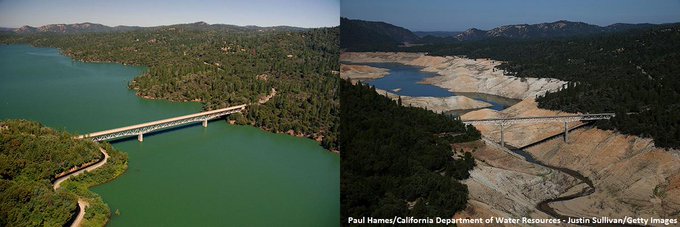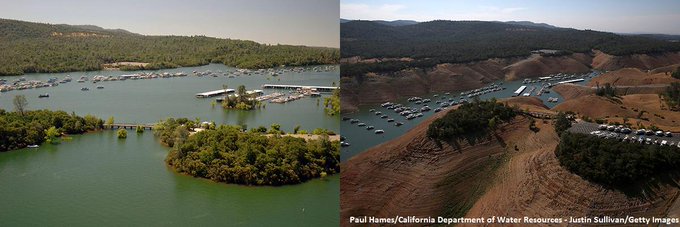By Brian Lada, Meteorologist
April 6,2015; 1:16AM,EDT
It is well known that California is in the midst of a historic drought, but a change in the weather pattern could help ease its severity.
A flip in the weather pattern will allow rain to spread across much of California this week as well as delivering much-needed snow to the Sierra Nevada.
This comes just days after California Gov. Jerry Brown announced the first-ever statewide mandatory water restrictions in an effort to reduce water usage due to the drought.
Wet Pattern Sets Up Early This Week
For much of the winter and early spring, storms have tracked north of California with only a small number of storms tracking far enough south to bring rain to the Golden State. A storm this week will be one of those storms.
A low pressure system is expected to spread rain across the state on Monday into Tuesday with some rain also reaching into portions of Oregon and Nevada.
The steadiest rain is forecast to fall over northern and central California, but some will make it down into Southern California.
"For many locations in central and Southern California, this will be the first measurable precipitation they have had since early March," said AccuWeather.com Meteorologist Michael Doll.
Rain from this storm will be far from enough to put a meaningful dent in the drought, but it will bring some short-term benefits.
Lawns and outdoor plants will get a healthy watering from the rain, helping homeowners save water.
People are urged to collect rain water and save it to water plants for when it turns dry again. This is one way to help conserve water, especially after the recent water restrictions that have been put in place.
RELATED:
California Governor Orders State's First-Ever Water Use Restrictions Following Record Low April Snowpack
Ken Clark's Western Weather Blog
Historic California Drought Forces Ski Resorts to Close Early
One of the longer-term benefits is the snow forecast to fall over the mountains.
"Parts of the northern Sierra Range will likely receive over a foot of snow," said Doll. "For the ski resorts that are still open, this will offer an opportunity to extend the ski season a while longer."
Snowmelt is heavily relied upon during the summer months when California is in its dry season. The water from melting mountain snow flows downstream, helping to fill water reservoirs.
The early week storm will not bring a significant amount of snow to the Sierras, but any amount of snow will help make up for the historically low snow pack this year.
According to AccuWeather.com Western Weather Expert Ken Clark, "At no time has the Sierra snowpack seen so little snow on April 1 as this year."
While good for the drought, the mountain snow could cause issues for those traveling through the mountains. Snow-covered roads could create treacherous travel for those driving through mountain passes, such as Donner Pass located along Interstate 80.
Return of Dry Weather
Unfortunately, the pattern of wet weather across California is not expected to last for long.
Much of the precipitation associated with the early week storm will depart the region on Wednesday as the storm tracks into the Plains.
This will leave behind dry and sunny weather for Thursday and Friday with dry conditions persisting into the weekend.
Striking before and after photos show the impact of California's struggle with 4-year drought: http://abcn.ws/19UeKJU
There are still some uncertainties with this system though, such as the path that it will take and the amount of rain it could unload across the West Coast.
Those with interests in California should check back with AccuWeather.com later in the week for more information concerning the potential for another rainstorm.
A Look at the Drought
The drought in California has been gradually escalating in severity over the last four years and is now at its worst level yet.
"It is no secret that the historic drought continues in California," said Clark. "For the fourth year in a row, rain and snowfall has been far below normal."
4 YEARS OF DROUGHT...Images of Half Dome in YNP taken every year on Mar 19th since 2012. #cawx
According to a report from the California Department of Water Resources, "Water conservation must become a way of life during the worst drought in most Californians' lifetimes."
The order is an escalation of Brown's January 2014 request that Californians voluntarily reduce their water usage by 20 percent.
However, this order did leave out one of the most important aspects of the drought: agriculture.
As much as 80 percent of water use in California is used for farming, according to Clark.
This could lead to higher prices at the supermarket to compensate for the higher cost of watering crops across California. A hike in food prices may be felt all across the country since California agriculture produces many of the fruits, vegetables and nuts in the United States.
The latest report from the U.S. Drought Monitor classifies nearly the entire state of California is in a drought.
The report, which was released on April 2, 2015, classifies 93 percent of California in a severe drought and 41 percent of California in an exceptional drought, the highest level of drought classification.
The Palmer Index, another way of analyzing drought conditions, also classifies a majority of the state of being in an extreme drought.
California is not the only state in the West experiencing a drought. The extreme drought conditions over much of California also extend into portions of Nevada and Oregon.
In total, the U.S. Drought Monitor states that more than 52 million people are being affected by drought conditions across the West.
Many more storms are required to put a significant dent in the historic drought.
Unfortunately, the clock is ticking before the dry season settles in across the West.





No comments:
Post a Comment